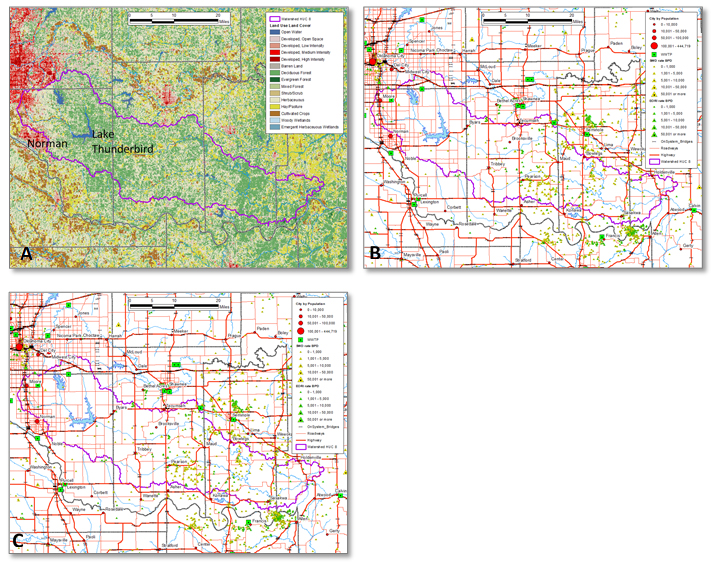
S3OK Research Perspectives for Little River Watershed Case Study
EPSCoR Update - Nov. 2021
Little River Watershed (LRW) is in central Oklahoma that drains into the Little River. The Little River, which is a tributary of the Canadian River flows from Moore, OK in Cleveland County and continues to flow southeastwardly across Pottawatomie, Seminole, and Hughes counties. Little River was dammed near Norman, OK to form Lake Thunderbird to provide drinking water for Norman, Midwest City, and Del City as well as recreational activities.
The Little River Watershed (Fig. 1) is in the cross-timber ecoregion of Oklahoma and has climatological transition zones. The watershed has a mix of urban and rural land uses and has associated issues such as Eastern Redcedar encroachment, growing human population, urbanization, and infrastructure needs. The watershed study area also has oil and gas production and has interest for water reuse.

Figure 1. Maps of (a) Land Use, (b) Oil and Gas Production, and (c) Population and Infrastructure in the Little River Watershed.
Hence, a case study in the LRW will provide S3OK researchers with a common problem to work on and creates opportunities for interdisciplinary research to overcome disciplinary silos among researchers.
During the Fall 2021 S3Ok Researcher Retreat, Focus Area leads Drs. Jeffrey Basara (Subseasonal to Seasonal Weather Patterns-S2S), Rodney Will (Terrestrial Water and Carbon Dynamics-TWCD), Hank Jenkins-Smith (Social Dynamics-SD), Muralee Muraleetharan (Sustainable Water and Energy Infrastructure-SI), and Robert Nairn (Variable and Marginal Quality Water Supplies-VMQW) presented how research from each focus areas converges to help us better understand the Little River Watershed and its issues and to provide possible solutions.
“The LRW is under climate division 5 and have general warming trend especially in the winter months based on the average annual temperature in the recent years,” Basara said. “We have a relatively wet period in the recent years although we have experienced drought periods in some years,” Basara added.
Within the last decade, the following extreme events occurred in the watershed: excessive rainfall (2013, 2015, 2019), drought/flash drought (2011, 2012, 2014, 2021), precipitation whiplash events (2012, 2015, 2019), heatwave conditions (2011, 2012), prolonged cold (2011, 2021), “significant” severe weather (violent tornado-2010, 2011, 2013; widespread destructive hail-2021), and extreme winter precipitation (excessive snow and ice storms- 2010, 2011, 2014, 2020, 2021).
“The S2S team wants to bring our climate expertise to work with other teams to find socially sustainable solutions to these wicked problems,” Basara said.
Historically, the watershed had a mix of oak forest, woodland, and savanna that was maintained by surface fire set every 3-7 years. Currently, the watershed is urban/exurban and has oak forest, native rangeland, and pasture. Prescribe fire is now mostly excluded throughout the watershed.
“There are some Eastern Redcedar (ERC) encroachment within the LRW’s oak forest and patches of ERC has been observed around Lake Thunderbird, which could impact water availability,” Will said.
“Increased aboveground carbon storage and water use does occur with Eastern Redcedar encroachment and densification of forest. Eastern redcedar encroachment into the prairie area leads to greater carbon storage, but also increases risk of wildfire,” Will said. “Within the watershed, implementation of ‘fire wise’ is strongly encouraged to reduce risk to dwellings and infrastructure within the wildland-urban interface,” Will added.
The TWCD team will look at tradeoffs between carbon storage and wildfire risk and will explore research opportunities for the management of rangeland to improve soil health within the watershed.
Human perceptions and beliefs are the heart of the most critical challenges facing Oklahoma, shaping behaviors, and collective decisions. The SD team will focus in obtaining public attitudes and perceptions especially in Norman and Oklahoma City (OKC), which are affected by the LRW.
“The SD team will be working to understand the population densities and population trends within the watershed. We also aimed to understand the key stakeholder groups in the study area to ensure OK Opinion Leader Advisory Network (OLAN) representation,” Jenkins-Smith said.
The SI focus area will advance understanding of the ways in which OK’s interdependent water and energy infrastructures interact with severe weather (i.e., ice storms), S2S extremes (pluvial events and droughts), earthquakes, carbon cycle patterns (changing land use and increased frequency and scope of wildfires), and water management/reuse patterns.
“In the LRW, the SI team will focus on the interdependencies of road transportation, electric power, water, and wastewater as well as the interaction of the infrastructure systems such as bridges, roads, networks of transmission lines, electric power lines with the SD, S2S, V-MQW, and TWCD issues,” Muraleetharan said.
The V-MQW focus area will address issues on water demands especially in the cities near Lake Thunderbird, which has degraded water quality due to urban runoff from Norman, Moore, and OKC as well as agricultural and rural run-off. Cities that are dependent on Lake Thunderbird will potentially have inadequate water supply due to increased human population projections in the area.
“The V-MQW team will explore multiple technologies for addressing water quality including augmentation of supply with reclaimed water,” Nairn said.
________________
Acknowledgment: We thank Dr. Kyle Murray for the Little River Watershed maps. Funding for this project was provided by NSF EPSCoR project grant OIA-1946093.
